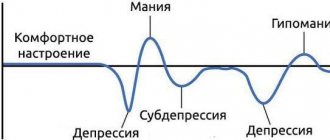| If you have discovered some of the described symptoms, this may indicate the development of a mental disorder. In this case, it is worth contacting a psychiatrist for diagnosis and initiation of timely treatment. In addition to face-to-face appointments , we offer a remote consultation service (online) , which is not inferior in quality to a personal meeting. Thus, you can receive qualified assistance from a high-level specialist, no matter where you are. |
Accompanying signs of the disease are: fear of self-worth, an oppressive feeling of emptiness (arising from difficulty in self-identification: what are my values, what do I believe in, what gives me pleasure), self-inflicted bodily wounds and dangerous behavioral patterns.
Psychological and mental testing
Tests are part of psychological and psychiatric diagnostics.
They help clarify important aspects of the mental state and understand a person’s personality. Tests are an aid in making a diagnosis. The presented tests were developed by specialists based on the clinical observations of the authors and are widely used in medical practice. At the same time, it is not recommended to diagnose yourself based on the results of psychodiagnostic tests. The tests have diagnostic value when administered by a psychiatrist or psychologist in conjunction with the assessment of a variety of other physiological and mental parameters.
But, if you are concerned about your own mental health, taking a test will not be a bad idea. Questionnaires usually include the main symptoms or complaints. By taking the test, you will be able to look inside yourself, ask the right questions, and analyze the emotions and sensations in the answers. The main advantage of the tests is their versatility and ease of use. And for additional detailed consultation and psychological help, it is better to contact a specialist.
Causes of BPD
Among the possible reasons for the development of borderline disorder are violence of a different nature (verbal, sexual, physical) in childhood, the lack of necessary protection and support from one or both parents, the loss of a person who served as a teacher, the fact that the child cannot separate himself and others (in the psychological aspect). The causal links to the development of BPD are the subject of ongoing debate among psychologists. But stable relationships in the family where the child grows up have been proven to inhibit the development of the disorder.
Neurological characteristics based on differences in brain activity (responsible for increasing and suppressing emotional pain) have a stronger connection with borderline disorder.
To make a diagnosis, a psychological assessment or questioning of the patient about the nature of the symptoms, the degree of severity, and how they affect the patient’s life is used. In general, borderline personality disorder is manifested by emotional instability, disturbance or uncertainty of self-identification, impulses and preferences (also of the sexual type), a constant feeling of emptiness, a tendency to become involved in unstable and stressful relationships (leading to repeated affective crises), repeated attacks bodily harm and suicide threats.
The official diagnostic criteria according to ICD-10, adopted in the Russian Federation, classify borderline personality disorder as an emotionally unstable disorder and define it as follows:
- behavioral and personal imbalance affecting the emotional sphere (external manifestations of emotions and feelings, control of motivation, perception and thought process, manner of relating to other people);
- abnormal behavior of a chronic nature that arose a long time ago;
- abnormal behavior is complete and disrupts socialization;
- occurs in childhood or adolescence and continues into adulthood;
- the disorder leads to distress, which becomes apparent only in the later stages;
- usually (but not always) leads to significant deterioration in social and professional areas.
To be diagnosed with a disorder according to the criteria of one of the subtypes defined by ICD-10, it must meet at least three of the listed criteria.
According to the criteria of DSM-IV, DSM-IV-TR and DSM-5 (diagnosis adopted in the USA and some English-speaking countries), borderline personality disorder is expressed in instability of interpersonal relationships, identification of the “I”, affective instability, and obvious impulsivity. Symptoms first appear at a young age and are observed in many situations. In addition to the general personality disorder criteria, a diagnosis of borderline disorder requires five or more of the following:
- Extreme persistence to avoid the fate (real or imagined) of abandonment.
- The tendency to be involved in relationships characterized by tension, instability and extreme intensity, ranging from enthusiastic idealization to severe disappointment and loss of value.
- Splitting of identity, obvious instability of the image and sense of “I”.
- Impulsive actions observed in at least two areas where self-harm is expected (embezzlement, promiscuity, substance abuse, dangerous driving, eating disorders).
- Recurrent suicide, threats or insinuations of suicide, causing bodily harm.
- Emotional instability, sudden changes in mood.
- Constant feeling of being lost.
- Uncontrollable attacks of anger, constant irritability, inappropriate aggressiveness (fights).
- Constant attacks of paranoia, clear signs of dissociation.
Test for schizophrenia
Diagnosing schizophrenia is far from simple. The diagnosis is made exclusively by specialists based on a combination of many factors. At the same time, there are a number of symptoms that occur in most patients with schizophrenia and are almost never found in other mental diseases. Back in the 30s of the last century, German psychiatrist Kurt Schneider identified 5 groups of symptoms of schizophrenia that are characteristic of this disease and called them “Symptoms of the 1st rank.” Numerous further studies showed that he was right in the sense that similar symptoms are diagnosed in 80% of patients suffering from schizophrenia. Therefore, they subsequently entered the official diagnostic criteria for the classification of mental disorders. The proposed test contains a description of symptoms that often occur in patients with schizophrenia (including symptoms of the 1st rank according to K. Schneider) and very rarely in other mental disorders.
Any mental disorder, even a relatively mild one, reduces the quality of life much more than many diseases of the body. Simple insomnia ultimately makes a person suffer more than, for example, gastritis. And it would seem that everyone whose psyche is suffering should run to the doctor as soon as possible and ask him for treatment. But in reality this does not happen. Chief Medical Doctor, Psychiatrist, Candidate of Medical Sciences, Felix Banshchikov talks about the misconceptions and fears that prevent you from receiving qualified psychiatrist help even when it is vitally necessary.
Symptoms of BPD
The first signs of the disorder usually appear in adolescence; over the years, disease statistics decrease and in almost 50% of patients the condition improves within ten years after the first symptoms appear. There are almost three times more cases of disease among women than among men.
The cornerstone of the disease is an unstable emotional state, the impetus for which was an excessive reaction to external events and inhibition of return to the previous emotional state. Susceptibility to such impulsive transitions is observed among those who are prone to sudden changes in evaluating people, from idealization to disappointment. Patients with this disorder have extremely intense sensitivity, they can be overwhelmed with love, joy, they can experience unprecedented elation, but at the same time they are also overwhelmed by negative emotions: anger and anxiety, fear and guilt. The intensity of emotions is so great that a substitution of reactions occurs: patients grieve greatly instead of the usual sadness, feel shame and humiliation instead of awkwardness, panic instead of a little excitement, reach the point of insanity instead of indignation.
With borderline disorder, the threshold of sensitivity to unsuccessful developments of events and to receiving refusal is high. Trying to avoid strong negative emotions, people suffering from BPD harm themselves and hide their feelings. The inability to control one's reactions sometimes leads to suicide. Despite short-term feelings of elation and light fun, the patient most intensely manifests anger and dejection, rage and loss, alternating anxious and depressive moods.
Impulsive behavior
(abuse of alcohol and/or psychotropic substances, excessive consumption of food or eating disorders, uncontrolled spending of money, promiscuous sexual relations, dangerous driving, sudden dismissal, sudden end of a relationship) reflects impulsive emotions - this is how a person strives to get rid of the strongest mental pain and the problems that cause it. But after some time, pain comes from repentance, a feeling of guilt for one’s action and, as a response, a desire for a new impulsive act in order to alleviate the new pain. Over time, this behavior in some cases becomes an automatic reaction to the pain of a negative emotion.
Self-harm
is one of the main symptoms of borderline disorder and is present in 80% of cases. The most common type of cut is made to the body. Also included are bites, varying degrees of burns, bruising, and head-banging. It is worth noting that up to 70% of patients cause physical harm to themselves without the intention of committing suicide. Self-harm here acts more as a way to punish oneself or to distract from the pain caused by a negative emotion. This is an attempt to evoke ordinary feelings in a situation of withdrawal from social fulfillment and can be an expression of anger or anger at difficult life circumstances.
The risk of suicide in BPD is up to 10%.
There is proven evidence that men are at greater risk (twice as high) of committing suicide than women. Suicidal tendencies and suicide attempts in patients with borderline disorder may indicate their belief that by doing so they will make life easier for others, that everyone will feel better. Such patients are especially sensitive to how people treat them: they are overly happy and grateful for good treatment and, conversely, are overly sad or angry when they are offended or criticized. The range of feelings is vast and their change occurs very quickly. Sometimes the mere possibility that the right person may disappear from life or that one may lose his respect is enough, and the pendulum of feelings swings from love to hate, from reverence to disappointment. Such sentiments harm not only specific relationships, they affect relationships in the family, in society, and on self-esteem.
With borderline disorder, there is a tendency to perceive the world as a dangerous place full of malicious people. At the same time, there is boundless devotion in romantic relationships, based on fear. This is facilitated by dissatisfaction with the partner, conflicts in the family and physical violence, chronic stress, and unwanted pregnancies. To protect itself from intense emotions caused by painful life events, the mind shifts its attention away from those events or memories of them. Blocking negative emotions temporarily alleviates impulsive feelings, but at the same time dulls ordinary emotions, causing a person with borderline disorder to lose the ability to concentrate and react naturally in everyday life, which significantly complicates his position in society.
Treatment of psychological diseases
A significant proportion of patients are cured or improve their condition thanks to well-developed structured therapeutic programs. As a rule, treatment of psychological diseases is carried out in stages:
- the patient's condition is diagnosed;
- An individual treatment plan is developed that takes into account the presence of other diseases, the patient’s living conditions, and his habits;
- obvious, acute symptoms of the disease are relieved;
- the patient is undergoing rehabilitation;
- the patient is provided with post-treatment support.
Since their first use in the early 1950s, a number of medications have changed significantly. Instead of “simple” aminazine, a long series of names appeared that really improved the lives of people with mental disorders. Nowadays, treatment is not limited to taking medications, no matter how effective they may be. Psychotherapy must be combined with drug treatment. Plus, great importance is given to prevention and preventing the patient from becoming seriously ill.
The combination of medicinal and psychotherapeutic effects beneficially and effectively changes the course of diseases such as depression, obsessive-compulsive and panic disorder, psychosis, and anxiety.
Features of adolescence
Teenager
- this is a person whose emotions are extremely mobile and are not retained for a long time; unfortunately, they can be quite superficial and shallow.
During adolescence, a person experiences a large number of revelations and discoveries. The experience of betrayal is especially difficult for him; adolescents have a very acute and slightly exaggerated attitude towards such important concepts for them at this age as friendship and love. And breaks in friendships and love relationships in adolescence are perceived as mental trauma, quite severe, sometimes catastrophic.
At this age, which is also called puberty
, we psychiatrists quite often encounter the onset of certain mental disorders.
Treatment for Borderline Personality Disorder
The diagnosis of borderline personality disorder is recognized as extremely difficult to choose a treatment method. Psychotherapy is considered the main therapeutic treatment approach for BPD.
The main difficulty is establishing a correct patient-psychotherapist relationship. For the patient, due to the symptoms of the disorder and the tendency to enter into unstable, tense relationships, having behavioral extremes and mood swings, it is extremely difficult to establish relationships and maintain them within certain limits. There are often cases when psychotherapists themselves do not undertake to work with such a disorder, protecting themselves from possible problematic situations.
As a treatment option, third wave psychotherapy is used - dialectical behavior therapy, the fundamental principle of which is the patients’ awareness of the variability in the perception of the situation. It is an eclectic approach that uses cognitive behavioral therapy techniques, effective communication techniques and meditation. Pharmacotherapy can also offer several second-generation drugs that are effective in stopping impulsivity and outbursts of uncontrollable anger.
When to seek professional help
Perhaps you or your loved ones have developed suspicious signs of one or another type of psychological disorder. This may include insomnia, fear, depression, short-term memory loss, loss of spatial orientation, and even hallucinations. In such cases, it is recommended to immediately contact a specialist!
Modern medicine has long used special diagnostic tests that make it possible to determine a real mental disorder in the early stages. So often the problem of simple emotional exhaustion and fatigue can be mistaken for a full-fledged mental disorder and vice versa. Therefore, you should never self-diagnose and try to recover by taking antidepressants or sedatives.
The Korsakov clinic uses a modern recovery method, approved not only by the Russian healthcare system, but also by a number of Western experts. The complex of mental health treatment measures also includes establishing a lifestyle, reducing stressful situations, establishing a healthy diet, fortifying the body, and protecting oneself from social and everyday problems. In the process of in-depth psychological assistance, a person’s social activity is restored and negative factors are neutralized. As a result of such actions, the nervous system usually returns to normal.
We also recommend reading the article about gambling addiction.
What are mental illnesses?
Mental illnesses are those that lead to mild or severe changes in thinking and behavior, disconnect a person from reality, and prevent them from adequately interacting with others, performing work, and everyday activities.
Mental disorders are very diverse - there are more than 200 types. The most common are depression, dementia (dementia), bipolar disorders, anxiety disorders, and schizophrenia.
The causes of mental illness are also different: genetic predisposition, biochemical changes (improper functioning of certain substances) in the nervous system, illness and injury, severe emotional shock, chronic stress. Often several different factors work in combination, some making a person predisposed, and others acting as a trigger.
List of psychological diseases
Mental disorders are quite common nowadays. Often they do not have a clear clinical picture. However, you should not neglect them completely. If you make a list of psychological diseases, it will turn out to be quite extensive. Nowadays, the concept of normal is interpreted quite broadly, however, if the symptoms are pronounced, you should not postpone a visit to the doctor, since delaying it over time will only worsen the situation.
In this regard, the list of psychological diseases makes sense for specialists and medical professionals, as a reference book. In everyday life it is not of great value, since without special training it is very easy to get lost in it. From a practical point of view, it makes sense to talk about a list of mental illnesses and their signs for which you should immediately visit a doctor.
Here is a list of the most dangerous and common diseases:
- obsessive-compulsive disorder;
- dementia;
- schizophrenia;
- addiction to drugs and alcohol;
- neurasthenia;
- patient's personality disorder;
- various types of phobias;
- reaction to persistent or severe stress.
It is worth clearly recognizing that the sooner the patient is in the hands of a specialist, the higher the outcome for a successful course of the disease or his full recovery.
Sexual desire disorders
At this age, the sexual sphere of a teenager
, his gender identity is finally formed. In cases where we are talking about personality disorders, impulse disorders are very common, including sexual desire disorders, and then we can find many different kinds of psychosexual anomalies, which also sometimes border on various kinds of events that have legal consequences. These are the kinds of troubles that teenagers can expect when we talk about psychopathy.
Borderline psychopathology
To begin, I would like to talk about borderline psychopathology, which often does not require any active psychiatric treatment, any drug intervention, or hospitalization.
In this case we are talking about behavioral disorders
, when those very violent emotions in behavior, when that very opportunism turns a person into a prickly creature, categorically refusing to discuss any issues peacefully, acting as a war against everyone.
In such situations, we talk about personality disorders, and this is a diagnostic category that exists in the classification of diseases. However, we still do not consider it a disease, since it is a character condition.
Character is not a disease
, character is what is given to a person by nature from birth. This is something that is being formed one way or another. And this is precisely the final phase of character formation, the very puberty age that we are talking about now. And this pubertal age, which lasts from approximately 11 to 17 years, is the determining age in the final formation of character traits.
After 17 years, the character that has been formed will remain unchanged, and all its pros and cons, positive and negative, strengths and weaknesses, as formed by this time, will remain so until the end of life.
I’m talking about this specifically in order to focus the attention of loved ones, relatives and, above all, parents on the significance of every psychological nuance associated with upbringing, or nuance associated with the attitude towards the problems of a teenager in his future life.
What seems unimportant, insignificant or insignificant to us adults, or what seems to us to be a rather successful pedagogical move, for a teenager can turn out to be an event with fatal consequences.
What to do if your loved one is mentally ill?
You need to prepare for the fact that your life can change greatly and learn how to behave correctly. A mentally ill person often becomes the center of attention for the entire family. Personal interests of household members fade into the background. We have to put up with the patient’s inappropriate behavior. You also need to prepare for the fact that the treatment may not work immediately. Sometimes the drugs prescribed initially do not help, and new ones have to be selected.
Yes, if a person has a mental illness, his relatives have a hard time. Some tips will help you withstand these stresses and maintain your own health:
- Control your emotions. Don't take what the patient says and does personally. Remember: he has no control over himself.
- Take breaks and find time to rest. You need to take turns sitting with the patient. If you don't have relatives who can help, hire a caregiver and have them come at least sometimes.
- If you feel emotionally damaged, see a psychologist or therapist. Don't wait for the problem to get worse.
- You must eat well and get enough sleep. Otherwise, you will not be able to cope with the load.
If you notice the symptoms described in this article in a loved one and think that they may be mentally ill, contact the specialists at the Cordia Clinic for help. Our experienced doctors will definitely try to help.
Teenage depression
At this age, symptoms and syndromes of those diseases that we more often see in adults also quite often develop. We can also observe the phenomena of so-called youthful depression, or depression with the phenomena of asthenic youthful insolvency
- that's what they are called.
During these depressions
the teenager falls into bed, stops going to school, snaps in response to his parents’ demands to pull himself together, go take a shower, clean himself up, and resume going to school. He stares mindlessly at the ceiling or plays the same computer game non-stop, stops communicating with his peers, turns to his phone, and social networks.
In such situations, in most cases, unfortunately, no one really thinks about depressive disorders; everyone only thinks about weaknesses of will, weaknesses of character, laziness, and the fact that this person needs to be given a kick so that he shakes himself up, gets up. Send him to some Suvorov school, start taking some tough measures with him, controlling, prohibiting this or that action.
All this, unfortunately, turns out to be ineffective and sometimes even pathogenic if we are dealing with real depression. And in teenagers, depression occurs exactly like this.
We may lose this teenager if we do not recognize this as a mental disorder in a timely manner and do not bother to consult psychiatrists. Unfortunately, the number of completed suicides
, that is, suicides ending in death are very high in adolescence.
At the same age, the number of various types of self-harmful actions
Moreover, the consequences of these self-harms are so serious that they actually disable the child for the rest of his life.
Neurotic disorders of adolescents
In a separate number of cases, we observe at this age disorders associated with some organic diseases associated with neurological and somatic pathologies.
Of course, we cannot ignore the neurotic disorders of adolescents. After all, it is at the end of this age that they are faced with, perhaps, the most difficult test for themselves and for their psyche - the unified state exam, the importance of which is exaggerated so much that for most teenagers the question of passing or failing this exam is a matter of life and death.
And many, many other problems and issues that are closely intertwined with psychological and social aspects.
Psychological diseases in children
No one spends as much time with children as their parents. Therefore, they have the greatest chance of identifying psychological diseases in children. Professional psychologists name the main signs by which one can judge the degree of need for medical care for a child:
- a sharp increase in the number of problem situations at school;
- your child is being abused or bullied by other children;
- the child commits actions that harm himself;
- avoids friends, avoids communication with family;
- frequent and sudden mood swings;
- your child is overcome by very strong emotions, such as anger, panic;
- ensuing apathy, lack of motivation to act;
- the child cannot concentrate on necessary matters;
- insomnia or nightmares;
- constant complaints of poor physical well-being;
- neglect of one's appearance;
- strong feelings about your appearance, a constant feeling of dissatisfaction with your appearance, figure, weight;
- appetite differs significantly from the norm in one direction or another.
If your observations are confirmed by a specialist, you should not lose your composure or panic. Remember, the child sees support in you and therefore you must remain strong in his eyes.
Obsessive-compulsive disorder
This type of disorder is characterized by increased caution, a tendency to doubt, a desire to keep everything under control, and obsessive thinking. People suffering from this type of personality disorder strive for perfection in everything, which greatly interferes with the completion of the task itself. They are overly conscientious, scrupulous, too pedantic and demanding of themselves and others.
Such patients are convinced that only their lifestyle and concepts are correct, and therefore demand that others conform to their ideas. Often, these individuals develop obsessive thoughts and peculiar rituals, expressed in the constant need to count objects, repeatedly check whether household appliances are turned off, whether the entrance doors are closed.
The financial side of life plays a special role for such people. They are overly frugal in spending, which they also demand from others; money is perceived as something that needs to be put aside in case of a global catastrophe.
During the period of compensation, individuals with this diagnosis are distinguished by reliability, pedantry, and correctness in communication. During decompensation, they are bothered by a growing feeling of anxiety, due to which the patient becomes irritable, remains in a gloomy state, and has hypochondriacal tendencies.










